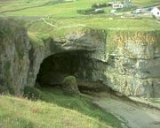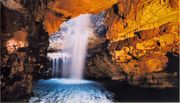
Smoo Cave
Encyclopedia
Smoo Cave is a large combined sea cave and freshwater cave in Durness
in Sutherland
, Highland
, Scotland
.
dolostone
s of the Durness Group (also known as the Durness Limestone). The cave has formed along the boundary between the light grey Sangomore Formation and the dark grey, mottled Sailmhor Formation (sometimes called Leopard Rock), both of which form part the Durness Group succession. These horizons close to the formation boundary are characterised by large and abundant chert
nodules which can be found all along the inner stream chamber where they have been left behind after dissolution of the surrounding dolostone. The cave was formed along two geological lines of weakness by a combination of erosion from the sea and an inland underground stream which has formed the innermost chambers. Upstream of the Allt Smoo which runs into the cave, impermeable quartzite
s have been faulted against the Durness Limestone, causing the stream to sink down into the carbonate rock soon after it has crossed the contact between the two different rock types.
 The cave is unique within the UK in that the first chamber has been formed by the action of the sea, whereas the inner chambers are freshwater passages, formed from rainwater dissolving the carbonate dolostones. Partway through the cave the waters of Allt Smoo also drop in as a 20m high waterfall. This is mainly due to the nearby dolostone - quartzite geological boundary where the Allt Smoo stream crosses the impermeable quartzites and sinks on meeting the permeable
The cave is unique within the UK in that the first chamber has been formed by the action of the sea, whereas the inner chambers are freshwater passages, formed from rainwater dissolving the carbonate dolostones. Partway through the cave the waters of Allt Smoo also drop in as a 20m high waterfall. This is mainly due to the nearby dolostone - quartzite geological boundary where the Allt Smoo stream crosses the impermeable quartzites and sinks on meeting the permeable
dolostones. Essentially the cave can be thought of as two caves formed by different mechanisms which have joined together over time. The cave is composed of three main sections; a large sea cave entrance chamber, a waterfall chamber and a short freshwater passage which leads to a terminal sump chamber with some interesting flowstone
formations at the rear.
The cave entrance and main chamber have been considerably enlarged by sea action to approximately 40m wide and 15m high, the largest sea cave entrance in Britain. The entrance is located at the end of a 600m long tidal gorge (Geodha Smoo) which was once part of the cave, now collapsed. Several remnant pillars can be seen along the eastern side of the Geodh along with a large section of the previous roof which has been partly buried by the grassy slope (normally covered by rocks spelling out the names of visitors to the cave). Interestingly, the sea rarely enters the sea cave nowadays (only during spring tides) as the area has undergone isostatic uplift.
The present-day cave is 83m long up to the terminal sump
at the rear of the third chamber / passage. The cave travels further however as an active stream of notable size resurges here at all times. Previous dye-testing has linked an underwater passage to an initial sink point in the Allt Smoo stream about 100m upstream from the main waterfall, implying that the cave system is at least twice as long as once thought. Cave divers belonging to the Grampian Speleological Group
have dived this sump to a distance of c. 40m, although large volumes of silt and peat in the water have prevented further exploration. It is worth noting that the main waterfall is often dry and will only become active once this upstream sink overflows.
Archaeological investigations have turned up Neolithic
, Norse
and Iron Age
artifacts, and it is thought that usage may extend back to the Mesolithic
age. The cave name is thought to originate from the Norse 'smjugg' or 'smuga' meaning a hole or hiding-place.
Durness
Durness is a huge but remote parish in the northwestern Highlands of Scotland, encompassing all the land between the Moine to the East and the Gualin to the West...
in Sutherland
Sutherland
Sutherland is a registration county, lieutenancy area and historic administrative county of Scotland. It is now within the Highland local government area. In Gaelic the area is referred to according to its traditional areas: Dùthaich 'IcAoidh , Asainte , and Cataibh...
, Highland
Highland (council area)
Highland is a council area in the Scottish Highlands and is the largest local government area in both Scotland and the United Kingdom as a whole. It shares borders with the council areas of Moray, Aberdeenshire, Perth and Kinross, and Argyll and Bute. Their councils, and those of Angus and...
, Scotland
Scotland
Scotland is a country that is part of the United Kingdom. Occupying the northern third of the island of Great Britain, it shares a border with England to the south and is bounded by the North Sea to the east, the Atlantic Ocean to the north and west, and the North Channel and Irish Sea to the...
.
Geology
Smoo Cave is formed within Early OrdovicianOrdovician
The Ordovician is a geologic period and system, the second of six of the Paleozoic Era, and covers the time between 488.3±1.7 to 443.7±1.5 million years ago . It follows the Cambrian Period and is followed by the Silurian Period...
dolostone
Dolostone
Dolostone or dolomite rock is a sedimentary carbonate rock that contains a high percentage of the mineral dolomite. In old U.S.G.S. publications it was referred to as magnesian limestone. Most dolostone formed as a magnesium replacement of limestone or lime mud prior to lithification. It is...
s of the Durness Group (also known as the Durness Limestone). The cave has formed along the boundary between the light grey Sangomore Formation and the dark grey, mottled Sailmhor Formation (sometimes called Leopard Rock), both of which form part the Durness Group succession. These horizons close to the formation boundary are characterised by large and abundant chert
Chert
Chert is a fine-grained silica-rich microcrystalline, cryptocrystalline or microfibrous sedimentary rock that may contain small fossils. It varies greatly in color , but most often manifests as gray, brown, grayish brown and light green to rusty red; its color is an expression of trace elements...
nodules which can be found all along the inner stream chamber where they have been left behind after dissolution of the surrounding dolostone. The cave was formed along two geological lines of weakness by a combination of erosion from the sea and an inland underground stream which has formed the innermost chambers. Upstream of the Allt Smoo which runs into the cave, impermeable quartzite
Quartzite
Quartzite is a hard metamorphic rock which was originally sandstone. Sandstone is converted into quartzite through heating and pressure usually related to tectonic compression within orogenic belts. Pure quartzite is usually white to gray, though quartzites often occur in various shades of pink...
s have been faulted against the Durness Limestone, causing the stream to sink down into the carbonate rock soon after it has crossed the contact between the two different rock types.
Physical description

Permeability (fluid)
Permeability in fluid mechanics and the earth sciences is a measure of the ability of a porous material to allow fluids to pass through it.- Units :...
dolostones. Essentially the cave can be thought of as two caves formed by different mechanisms which have joined together over time. The cave is composed of three main sections; a large sea cave entrance chamber, a waterfall chamber and a short freshwater passage which leads to a terminal sump chamber with some interesting flowstone
Flowstone
Flowstones are composed of sheetlike deposits of calcite formed where water flows down the walls or along the floors of a cave. They are typically found in "solution", or limestone caves, where they are the most common speleothem. However, they may form in any type of cave where water enters that...
formations at the rear.
The cave entrance and main chamber have been considerably enlarged by sea action to approximately 40m wide and 15m high, the largest sea cave entrance in Britain. The entrance is located at the end of a 600m long tidal gorge (Geodha Smoo) which was once part of the cave, now collapsed. Several remnant pillars can be seen along the eastern side of the Geodh along with a large section of the previous roof which has been partly buried by the grassy slope (normally covered by rocks spelling out the names of visitors to the cave). Interestingly, the sea rarely enters the sea cave nowadays (only during spring tides) as the area has undergone isostatic uplift.
The present-day cave is 83m long up to the terminal sump
Sump (cave)
Sump is a term used in caving to describe a submerged passage in a cave. A sump may be static, with no inward or outward flow, or active, with continuous through-flow...
at the rear of the third chamber / passage. The cave travels further however as an active stream of notable size resurges here at all times. Previous dye-testing has linked an underwater passage to an initial sink point in the Allt Smoo stream about 100m upstream from the main waterfall, implying that the cave system is at least twice as long as once thought. Cave divers belonging to the Grampian Speleological Group
Grampian Speleological Group
The Grampian Speleological Group is the oldest caving club in Scotland, having been founded in 1961. It is also the largest, with members exploring caves across Britain and the world.-External links:** BBC report on GSG's retrieval of ancient remains...
have dived this sump to a distance of c. 40m, although large volumes of silt and peat in the water have prevented further exploration. It is worth noting that the main waterfall is often dry and will only become active once this upstream sink overflows.
Archaeological investigations have turned up Neolithic
Neolithic
The Neolithic Age, Era, or Period, or New Stone Age, was a period in the development of human technology, beginning about 9500 BC in some parts of the Middle East, and later in other parts of the world. It is traditionally considered as the last part of the Stone Age...
, Norse
Norsemen
Norsemen is used to refer to the group of people as a whole who spoke what is now called the Old Norse language belonging to the North Germanic branch of Indo-European languages, especially Norwegian, Icelandic, Faroese, Swedish and Danish in their earlier forms.The meaning of Norseman was "people...
and Iron Age
Iron Age
The Iron Age is the archaeological period generally occurring after the Bronze Age, marked by the prevalent use of iron. The early period of the age is characterized by the widespread use of iron or steel. The adoption of such material coincided with other changes in society, including differing...
artifacts, and it is thought that usage may extend back to the Mesolithic
Mesolithic
The Mesolithic is an archaeological concept used to refer to certain groups of archaeological cultures defined as falling between the Paleolithic and the Neolithic....
age. The cave name is thought to originate from the Norse 'smjugg' or 'smuga' meaning a hole or hiding-place.
Tourism
The cave is located 2 km east of the village of Durness and is presently served by a car park, toilets, stairs and walkways. Plans are being considered for access improvements for the estimated 40,000 visitors it receives annually. Tours of the cave also operate during summer months, taking visitors to the inner chamber by boat.External links
- SmooCave.org, information about the cave

